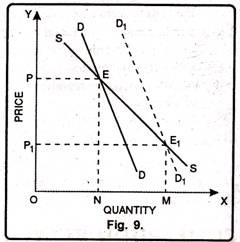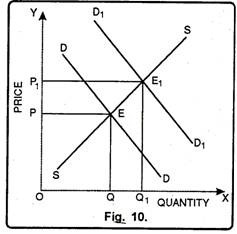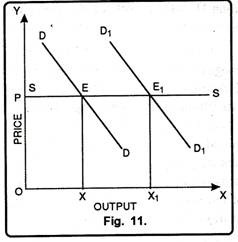Determination of Normal Price Under Laws of Returns!
Normal price is influenced by laws of returns. Price is influenced through cost of production which may be increasing if there are dividing returns, decreasing if increasing returns or retains constant if constant returns.
A. Normal Price and Law of Increasing Returns (Diminishing Costs):
Law of increasing returns in also known as law of diminishing costs. According to this law, when production of a commodity in the long run is increased, industry enjoys several economics of scale. Consequently, AC and MC of the industry fall. Since normal price is equal to MC and AC, so it also falls.
In Fig. 9, SS is supply curve which slopes downward. It signifies that as production increases, cost decreases. Suppose, initial demand curve is DD which intersects supply curve SS at point E. As such equilibrium price is OP, and equilibrium output ON.
ADVERTISEMENTS:
When demand increases, as shown by D1D1 it intersects supply curve SS at point E1. Here price will fall to OP1. Thus, we find that if an article is produced under law of increasing returns, normal price would fall if demand increases and rise if demand falls.
B. Normal Price and Law of Diminishing Returns (Increasing Costs):
This law is also known as law of increasing costs. Accordingly, when industry increases production it faces many diseconomies of scale. Therefore, marginal and average costs begin to rise. Rise in costs leads to rise in price because in the long run, price is always equal to marginal and average cost.
ADVERTISEMENTS:
In Fig. 10, SS supply curve slopes upward from left to right. It shows that as more and more quantity is produced, cost of production also goes on increasing. Suppose, initially demand curve is DD. It cuts supply curve SS at point E.
Thus OP will be the equilibrium price and OQ the output. When demand increases to D1D1 new equilibrium prevails at point E1 where it cuts SS supply curve. Here, price is OP1 at which production increases to OQ1. In this way, we see that if an article is produced under diminishing returns, normal price would rise if demand increases and would fall if demand decreases.
C. Normal Price under Constant Cost Industry:
According to this law, whenever output is increased, its average and marginal costs remain constant. In other words, increase or decrease in production has no influence on normal price.
In Fig. 11, SS is the supply curve which is parallel to X-axis. It signifies that normal price remains constant irrespective of increase or decrease in output. Suppose, DD is the initial demand curve which intersects the supply curve at point E.
It determines equilibrium price OP and output OX. Now demand increases and demand curve shifts to D1 D1. The new equilibrium is established at E1 but normal price remains OP though output increases to OX1. Therefore, if an article is produced under constant costs, normal price remains the same irrespective of a rise or fall in demand.
Thus, from the above we can conclude that in the long run with the increase in demand, long run price may rise, remain same or fall. It will depend on the point whether the industry faces the law of increasing, constant or diminishing costs.


